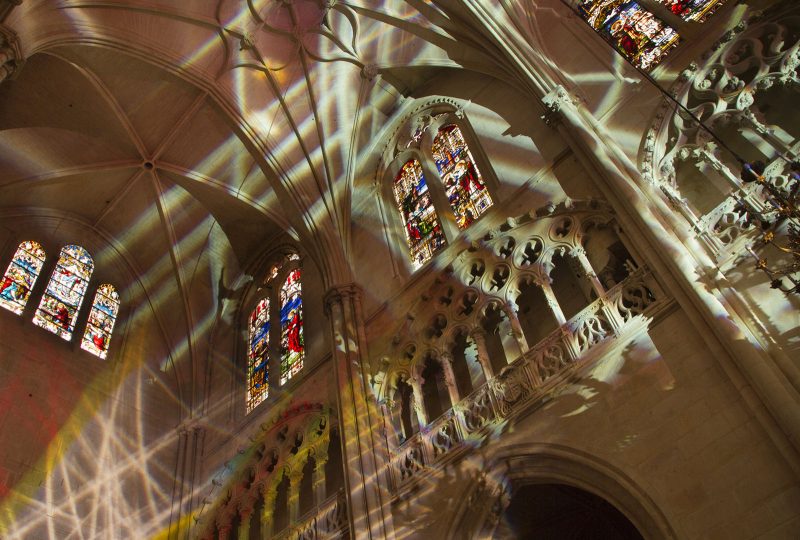
Brilliant Burgos
In mid-November, the medieval cathedral of Burgos in northern Spain was lit from within–not by any divine power, but by the miracle of technology. For her temporary light installation “Chromotopia Santa María,” (November 3-13, 2016) Vienna-based artist Victoria Coeln used projected rays of light in brilliant colors to fill the ample space of the cathedral, the white limestone walls intensifying the vivid colors. It’s as if the cathedral’s stained glass windows had turned themselves inside out, dissolving the solid stone structure into layers of light. The result looks immersive and transcendent, but my inner historian keeps my feet on the ground and compels me to consider the bigger picture.
Burgos is a study in contrasts. Home to one of the most stunning medieval cathedrals in Spain, the city is famous for its delicious blood sausage (morcilla de Burgos–way tastier than it sounds), and for its newly built Museum of Human Evolution, which interprets the nearby archeological site of Atapuerca, where the earliest human remains in all of Europe have been found. Burgos is a wealthy, bustling regional center, but I could tell during my visits there in 2010 and 2011 that it’s a deeply politically conservative city. History helps explain why. During the Spanish Civil War (1936-1939), Burgos functioned as the capital for General Francisco Franco’s fascist-leaning government, and Burgos Cathedral itself was chosen to be the ceremonial site for his victory celebration (after he won the Civil War). But this dark episode is not part of the romanticized vision of the past offered to the cathedral’s visitors today.

Losing a sense of place
But what does all this have to do with a beautiful Austrian light installation? To me, it’s a way to think about where we locate the “contemporary” in contemporary art, and the “site” in site-specific art. If we’re just going to experience “Chromotopia Santa María” in the here-and-now and lose ourselves in the disembodied rays of light, we lose the specificity of the site itself and its complex history. The installation becomes generic–we could be in any impressive cathedral. And, indeed, looking at the fine print in the press release, I found that this is exactly what happened here. The artist used the very same glass filters she used for installations in Vienna’s Stefansdom cathedral and the so-called “Monk’s Valley” of Cappadocia in Turkey.
The stained glass in Burgos Cathedral has its own history, which has been completely ignored in this installation. Most of the original glass was destroyed by Napoleonic troops in 1813, but the fragments of medieval glass that survive are among the oldest in Spain. The rich red glass in particular uses a complex technique of superimposed layers of color to create deep, intense reds with subtle variations due to their handmade production. This is precisely the opposite of the technological cookie-cutter approach of “Chromotopia Santa María,” in which virtually identical light projections are used at historical sites in Turkey, Austria, and elsewhere.
Historical sites can be activated and engaged by contemporary art. Every ten years, the Münster Sculpture Project in Germany fills the city and its monuments with works of contemporary art that engage the place and its past. For example, in 1987, Rebecca Horn’s “Contrary Concert” filled the space of a historic prison later used by the Gestapo with light and music. In the United States, curators like Mary Jane Jacobs have sought to give voice to our own hidden histories, as in her 1991 Places with a Past in Charleston, SC, which included Antony Gormley’s installation of headless bodies suspended from the ceiling of the city’s Old Jail. But all too often, historical sites are used in ways that flatten out their specificity and complexity. Even though we might want Burgos Cathedral to be a site of spiritual transcendence, we shouldn’t let bright lights distract us from the deeper, sometimes darker, reality.










